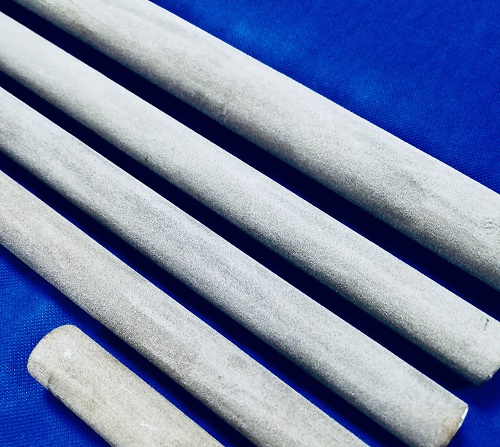|
|
 |
|
| ■ Location : Home > NEWS > Lord Fin Tube--High flux tube for heat exchanger |
|
 |
|
| Lord Fin Tube--High flux tube for heat exchanger |
High Flux Tubes represent a significant advancement in heat exchanger technology, offering superior thermal performance and energy efficiency compared to conventional heat transfer tubes. These specialized tubes are engineered with a unique sintered inner surface that dramatically enhances heat transfer coefficients while reducing fouling tendencies.
Industry Insight: High Flux Tubes can achieve heat transfer coefficients 2-3 times higher than plain tubes, making them particularly valuable in applications where space constraints or energy efficiency are critical factors.
Manufacturing Process of High Flux Tubes
The manufacturing of High Flux Tubes involves sophisticated metallurgical processes to create the specialized porous surface structure that enhances heat transfer performance.
1. Material Procurement and Quality Verification
- Source high-quality base tubes meeting ASTM/ASME standards
- Comprehensive material certification review
- Dimensional validation including OD, ID, wall thickness, and straightness
- Surface quality inspection for defects and contaminants
2. Surface Preparation and Treatment
- Chemical cleaning to remove oils, oxides, and surface contaminants
- Mechanical abrasion to enhance surface adhesion properties
- Surface activation for optimal coating adhesion
3. Powder Application Process
- Uniform application of metallic powder (iron, copper, or specialized alloys)
- Controlled powder particle size distribution (typically 50-200 microns)
- Precision spraying to achieve consistent coating thickness
4. Sintering Thermal Treatment
- Controlled atmosphere heating to 750-850°C
- Precise temperature profile management
- Dwell time optimization (typically 20-40 minutes)
- Metallurgical bonding of powder particles to base tube
5. Controlled Cooling and Final Inspection
- Gradual cooling to prevent thermal stress
- Microstructural examination of sintered layer
- Performance validation testing
- Quality certification and documentation

Microstructure of High Flux Tube surface showing enhanced porous layer for improved heat transfer
Performance Advantages of High Flux Tubes
2-3X
Higher Heat Transfer Coefficient
30%
Smaller Heat Exchanger Size
Technical Performance Comparison
| Parameter |
Standard Tubes |
High Flux Tubes |
Improvement |
| Heat Transfer Coefficient (W/m²K) |
800-1,200 |
2,000-3,500 |
150-200% |
| Nucleate Boiling Enhancement |
Base Reference |
3-5X |
200-400% |
| Fouling Resistance (m²K/W) |
0.0002-0.0005 |
0.00005-0.0001 |
75-80% Reduction |
| Pressure Drop Increase |
Base Reference |
20-40% |
Minimal Impact |
| Service Life (Years) |
10-15 |
15-25 |
50% Extension |
Material Specifications and Applications
Available Materials and Specifications
| Base Material |
Coating Type |
Temperature Range |
Pressure Rating |
Typical Applications |
| Carbon Steel |
Iron Powder |
-20°C to 400°C |
Up to 150 bar |
Refineries, Chemical Plants |
| Stainless Steel 304/316 |
Stainless Steel Powder |
-200°C to 800°C |
Up to 200 bar |
Pharmaceutical, Food Processing |
| Copper & Copper Alloys |
Copper Powder |
-100°C to 300°C |
Up to 100 bar |
HVAC, refrigeration |
| Nickel Alloys |
Nickel Powder |
-200°C to 900°C |
Up to 250 bar |
High-temperature processes |
High Flux Tubes Applications
Chemical Processing
High Flux Tubes are extensively used in reboilers, condensers, and reactors where enhanced heat transfer improves process efficiency and reduces equipment size.
- Distillation column reboilers
- Evaporators and crystallizers
- Polymer processing reactors
Power Generation
In power plants, High Flux Tubes improve the efficiency of feedwater heaters, condensers, and waste heat recovery systems.
- Feedwater heaters
- Steam surface condensers
- Waste heat boilers
Refining & Petrochemical
The refining industry benefits from High Flux Tubes in critical heat exchangers where fouling resistance and thermal efficiency are paramount.
- Crude oil preheat trains
- Hydroprocessor exchangers
- FCC unit heat recovery
Design Considerations for High Flux Tubes
Engineering Note: When designing heat exchangers with High Flux Tubes, consider the enhanced heat transfer characteristics to optimize bundle geometry and reduce overall equipment size while maintaining performance.
Key Design Parameters
- Tube Pitch Optimization: Account for enhanced heat transfer when determining tube layout
- Flow Distribution: Ensure proper fluid distribution to maximize performance
- Thermal Stress Analysis: Consider differential expansion between enhanced and plain sections
- Cleaning Considerations: Plan for mechanical cleaning requirements in fouling services
- Cost-Benefit Analysis: Evaluate premium cost against space savings and energy efficiency gains
Economic Benefits and ROI Analysis
| Benefit Category |
Impact |
Typical Value |
| Capital Cost Reduction |
Smaller heat exchanger size |
15-30% equipment cost savings |
| Energy Cost Savings |
Improved thermal efficiency |
25-40% reduction in energy consumption |
| Maintenance Cost Reduction |
Reduced fouling and longer service intervals |
20-35% lower maintenance costs |
| Space Savings |
Compact heat exchanger design |
30-50% footprint reduction |
| ROI Period |
Payback time for premium investment |
6-18 months typical |
High Flux Tubes represent a proven technology for enhancing heat exchanger performance across multiple industries. Their ability to significantly improve heat transfer coefficients while reducing fouling makes them an attractive solution for both new designs and retrofitting existing equipment.
For specific application engineering or technical consultation regarding High Flux Tubes, contact our engineering team to discuss how this technology can optimize your heat transfer processes.
|
|


